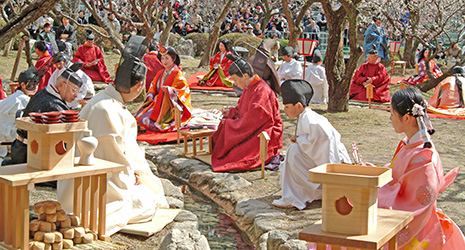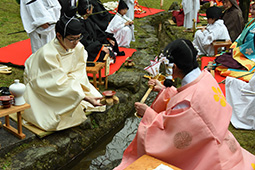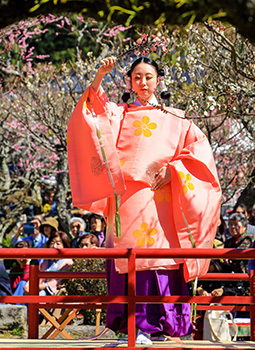INDEX
- English
- 日本語

Participants write poems during the Kyokusui-no-En (meandering stream ceremony) - English
- 日本語

Shinji-ike Pond in the garden of Dazaifu Tenmangu


Participants write poems during the Kyokusui-no-En (meandering stream ceremony) 

Dancers perform during the Kyokusui-no-En ceremony
May 2021
The Kyokusui-no-En Ceremony in the Garden of Dazaifu Tenmangu

A ceremony is held in the garden of Dazaifu Tenmangu in Fukuoka Prefecture that reenacts a ceremony performed at the Imperial Court during the Heian period (late eighth to late twelfth century), when court culture flourished in Japan.


Dazaifu Tenmangu in Dazaifu City, Fukuoka Prefecture, enshrines Sugawara Michizane (845–903), known as the deity of learning. The shrine was founded in 905, and when shrine buildings were constructed on Michizane’s burial site in 919, a vast garden with a pond is also said to have been built.
“The garden as a whole at Dazaifu Tenmangu is called “Byozen Teien” (Mausoleum Garden). It was created to appease the soul of Sugawara Michizane, who was a minister in the Imperial Court but was falsely accused and relegated to the Dazaifu local government office, and later died here,” says Misake Yasunori, 42nd generation descendant of Umasake Yasuyuki, a disciple of Michizane who buried him with great care.
Michizane is also known as one of the most famous poets of his time (a composer of waka*, a traditional Japanese poetic form). A poem was included in the Hyakunin Isshu**, and is still being recited today.


A traditional ceremony is held at a garden associated with the poet Michizane. That garden, located on the east side of the honden (main sanctuary), is the Kyokusui Garden, through which a beautifully meandering stream flows. On the first Sunday in March every year, when Michizane’s beloved plum blossoms are in full bloom, a reenactment of a Heian-period Imperial Court ceremony is held called Kyokusui-no-En (meandering stream ceremony). (The ceremony, known in English as the Poetry Composition Ceremony, was cancelled in 2021 due to COVID-19.) The ceremony begins with a traditional dance performance, after which the waka poets, dressed in the courtly attire of the time, sit on the banks of the stream. The poets compose a waka poem on the subject of plum blossoms in full bloom and write it in calligraphy on a tanzaku strip of paper before a floating sake cup released upstream reaches them. They then take the sake cup and drink from it. After that, they hand their tanzaku to the children serving as assistants in the ceremony.
Having started in 958 as a requiem for the soul of Michizane, the ceremony was eventually discontinued between the late 15th century and modern period before being revived in 1963. In the late 1970s, pure water was drawn from the nearby forest to create the present-day, full-scale Kyokusui Garden.

Says Misake, “The Kyokusui-no-En ceremony was a means of self-purification by exorcizing evil spirits from the body and soul through the power of the water spirits. In the Heian period people were plagued by disease, so it also expressed a wish to purify the source of disease through the power of water.”
The garden is at its most spectacular when the 6,000 plum trees are in full red and white bloom around the time of the ceremony, when it serves as a stage for reenacting the elegant court scenes of ancient times.
* A classic Japanese poetic form consisting of 31 syllables divided into five parts with five, seven, five, seven and seven (5-7-5-7-7) syllables in each.
https://www.gov-online.go.jp/eng/publicity/book/hlj/html/202010/202010_02_en.html
** The Hyakunin Isshu is a classical Japanese anthology of 100 Japanese waka by 100 poets
https://www.gov-online.go.jp/eng/publicity/book/hlj/html/202010/202010_03_en.html

